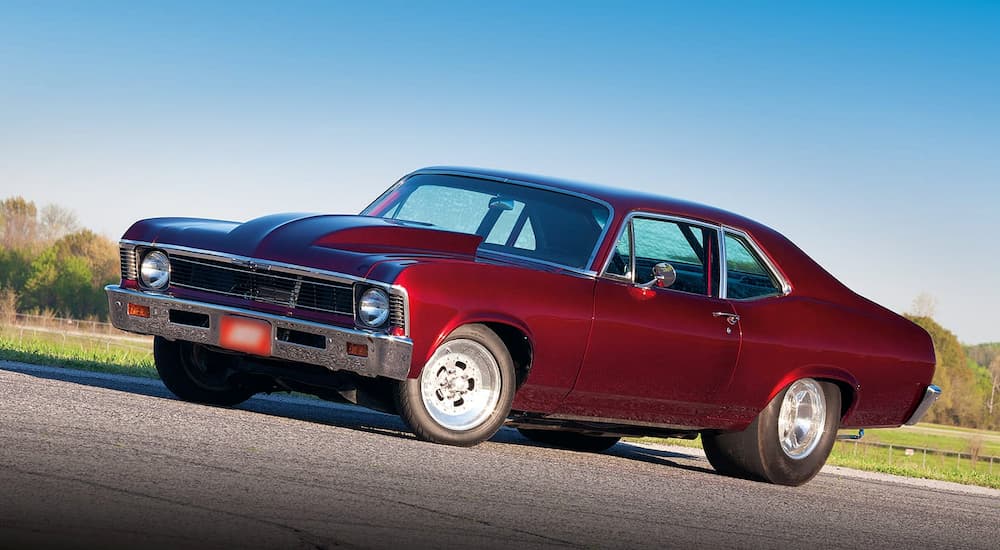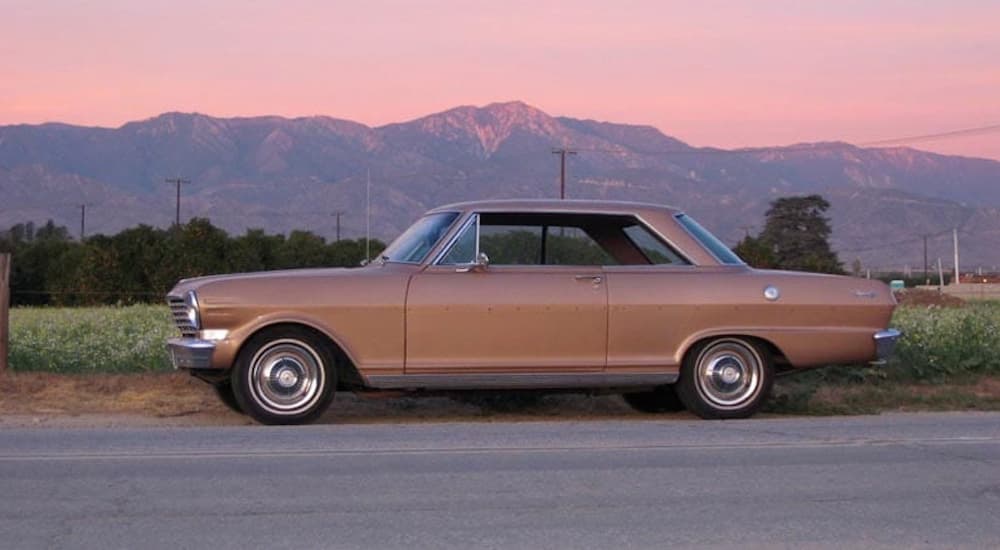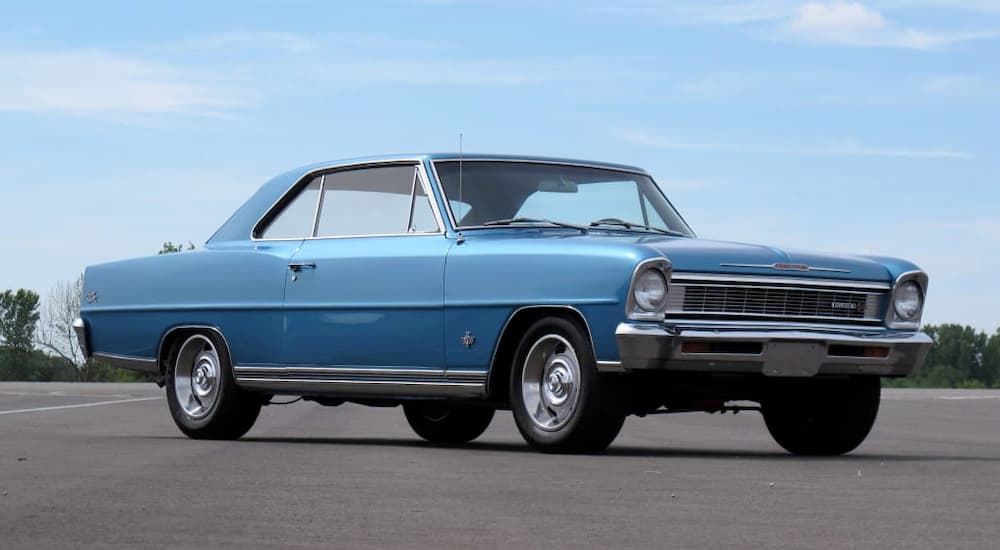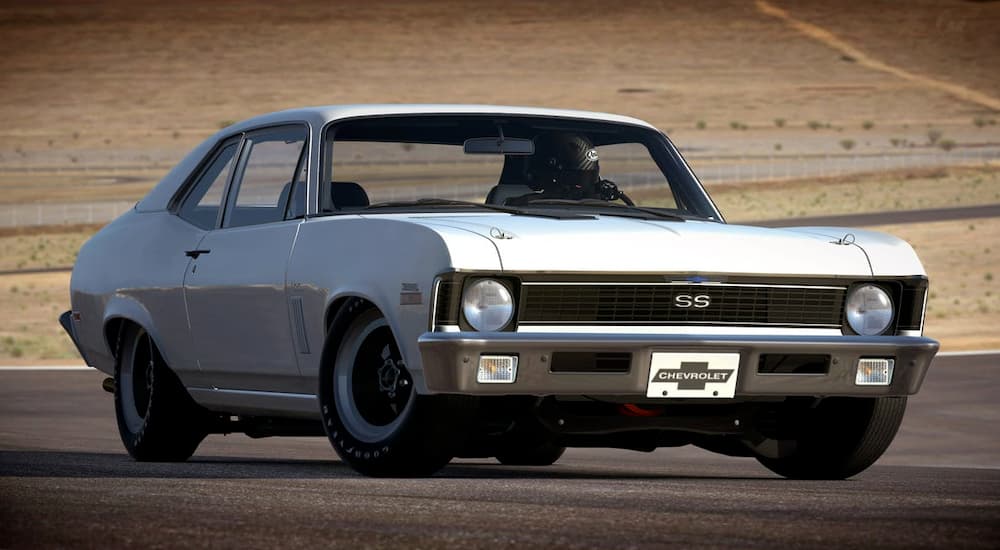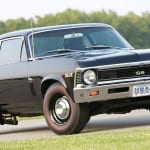The Chevy Nova was a compact competitor in the legendary American pony wars. While the 1960s and 1970s witnessed a fight between American automotive manufacturers to produce the fastest and most powerful muscle cars, the Chevy Nova was just right when it came to size, speed, and affordability. But it didn’t start out as the Chevy Nova…not quite, anyway.
Eager to produce a budget-friendly compact muscle car, Chevy introduced the Chevy II. As a model name, Nova was relegated to runner-up name because it didn’t start with C. However, Nova was chosen as the name for the higher-end, sportier trim option, and did eventually replace Chevy II as the car’s official name in 1969. Produced between 1962-1988 (though some people will tell you the Nova died in the 70s), you would be lucky to find a used Chevy Nova at your Chevy Dealership.
Early Days…1962-1965
After the Chevy II’s rapid-fire design and subsequent approval, which led to its manufacture only eighteen months later, this car was among the speediest new car development programs released by General Motors. Designed in 1961 and released in 1962, the Chevy II was a back-to-basics compact car, smaller than the full-size Chevy vehicles, but bigger than the compact Chevy Corvair. Available as a two-door coupe, four-door sedan, convertible, or station wagon, the simple design of the Chevy II represented what Chevy’s General Manager, Ed Cole, dubbed “maximum functionalism with thrift.”
The first generation ran from 1962-1965, with a few notable highlights. Equipped with either a 153 cubic-inch four-cylinder or 194 cubic-inch six-cylinder engine, the Chevy II quickly evolved to include sportier options. The Super Sport, or RPO-Z03, was released in 1963 on the Chevy II Nova 400. Although it wasn’t much of a performance booster, the trim, bucket seats, new instruments, and spiffier steering wheel gave the car a spicier appearance, making it seem sportier than its performance actually was.
This was the only year that the Chevy II Nova SS was available as a convertible. The following year brought about a larger, 283 cubic-inch engine, able to generate either 195 or 220 horsepower. Already lightweight, this engine upgrade edged the Chevy II into muscle car territory, zipping it from 0-60 mph in 11.3 seconds and crushing the quarter-mile in eighteen. The final year, 1965, of this first generation delivered additional muscle to the engine in the form of a 327 cubic-inch V8 engine, generating 300 horsepower, available in a Powerglide transmission.
Short, but Sweet…1966-1967
Although short, the second generation brought about a new and faster Chevy II model. Equipped with a 327 cubic-inch eight-cylinder engine, this model year boasted 350 horsepower and completed the quarter mile in 15.1 seconds, shaving nearly three seconds off its earlier record. Not much changed with the 1967 Chevy II models, other than some additional cosmetic enhancements.
Long Haul…1968-1974
Finally!
We can drop the Chevy II name in favor of simply Chevy Nova. The Nova, redesigned in 1968 as the Nova SS, was mechanically and aesthetically based off the Chevy Camaro. Outfitted with the standard 350 cubic-inch V8, generating 295 horsepower, there was also the available 396 cubic-inch V8, which boosted horsepower between 350-375.
The L34 option generated 350 horsepower, while the L78 generated 375 horsepower. Only 234 Novas were equipped with the L34 engine configuration, and 667 Novas featured the L78, making them both targets of car collectors. 1969 came and went without many significant changes to the Nova.
An available Yenko Nova 427 cubic-inch eight-cylinder engine generated a maximum 425 horsepower with 460 lb.-ft. of torque, but only 37 were created during that year, making them another classic car collectible. Those of us familiar with car history, or those of us who were alive during the seventies, can attest to the muscle car parade being rained on by emissions regulations, increased safety requirements, and the astronomical price of gas…when gas was actually available. With respect to safety initiatives, automotive manufacturers were forced to decrease horsepower in favor of additional safety features, which resulted in heavier vehicles, straining performance and power.
The 1970 Nova featured a modified 396 cubic-inch engine, which boosted its size to 402 cubic-inches, generating 375 horsepower. With performance no longer a priority, the 1971 Chevy Nova was given a 350 cubic-inch engine, which got a maximum of 270 horsepower. Not surprisingly, after the previous power and performance of earlier Novas, sales of the 1971 Nova started to slip.
Chevy tried to bolster its sliding sales by releasing the Rally Nova, or RPO-YF1, reminiscent of a race car, but without the actual performance of one, and only lasted until 1973. The year 1972 introduced a Nova with a 350 cubic-inch V8 engine, able to get 200 horsepower, while 1973 just brought with it additional compliance with federal regulations, and cosmetic enhancements, including: bigger bumpers and rear side mirrors, as well the availability of a hatchback. More regulations influenced the 1974 Nova, but the biggest change was cosmetic, and came as a “Spirit of America,” one-year option, which unveiled red, white, and blue accented trim levels.
The Fourth…and Almost Final Generation…1975-1979
Due to additional regulations, the 1975 Nova now came standard with mechanical changes to the brakes, suspension, and tires. Because of emissions concerns, the 1975 Novas were equipped with catalytic converters to reduce emissions, disc brakes were a required safety feature, as were steel-belted radial tires. In 1976, the Nova’s 262 cubic-inch engine was replaced by a new 305 cubic-inch eight-cylinder engine, as part of the Gold Medalist package, designed in honor of the 1976 Olympic Games.
By 1977, production ended on the Nova SS, and sales plummeted, especially in the shadow of other new Chevy releases. The fourth generation lasted until 1979, but the Nova made an unexpected return in 1985. More than a few collectors gladly ignore models from the 1980s and insist the Nova met its demise in the 70s.
Final Call…1985-1988
Chevy resurrected the Nova badge in the spring of 1984 and released the fifth generation of Novas between 1985 and 1988. Built on the same platform as the Toyota Corolla, the Chevy Nova was a front-wheel drive subcompact car equipped with a 1.6-liter, 98 cubic-inch four-cylinder engine, operated by either a five-speed manual or a three or four-speed automatic transmission.
Rumor Reversal
You know those urban legends kids tell each other to scare or gross themselves out? Or to seem very worldly, even though their “facts” are based in…um…falsehoods? Yeah, well, in some ways the marketing and automotive industries are like those kids on the playground. A popular “fact” about the Chevy Nova has been widely circulated as a cautionary tale with respect to branding. Who knows where or when it started…neither really matters, if it was even possible to find out with any certainty.
But, for ages now, automotive lore insists that the Chevy Nova did not sell well abroad because in Spanish “nova” means “no go.” No way!
There are a couple of problems here: the first involving numbers, while the second involves letters, or rather the lack of spacing between them. The Chevy Nova actually sold very well throughout Mexico and Venezuela both of which are Spanish-speaking countries. It’s likely that any slump in sales abroad would have been mirrored by disappointing sales in the States. In other words, it was a sales trend, not a semantic smoking gun.
Speaking of semantics… “nova” in Spanish doesn’t actually mean anything. There must be a space between “no”and “va”, as in “no va,” in order for it to have meaning. And even then, the translation of “no go” is tenuous at best, and not the phrase a Spanish-speaking driver would use to indicate a car that wasn’t running. In that case, you would expect to hear, “no marcha,” or “no funciona,” to indicate that a car was somehow faulty.
Nova no go? Not a chance.
What Went Wrong?
Now that the great Chevy Nova is dead and buried, where does that leave us? Thankfully, there are still plenty of performance cars from different manufacturers – including Chevy – to choose from, but somehow they’re just not the same. There was something about the Nova that set it apart; maybe it was the design, the overall shape and form of it that was different from what else was out there. The appearance and presence of the Chevy Nova made an impact – you can see this from the fact that it has lingered in media and pop culture for generations as an expression of American automotive power.
I think that’s a big part of why the later Novas failed to make an impression or sell well once they were released. To be fair, performance was a big part of it; I mean the models from the late ’70s, and the return in the ’80s really weren’t the same as those first couple generations. Not even close. But the safety and environmental regulations that helped bring an end to the Nova hit every sports car on the market – yet some of them have survived and thrived in the modern automotive era.
So what happened with the Nova? I think it came down to the fact that Chevy didn’t have a real place for it in their lineup anymore. They tried to figure out a way to make it work in a changing market with new requirements and expectations, but that could never work. People who wanted a Nova because of what that name represented would never buy something that lacks the very essence of what they’re looking for. At the same time, potential customers who wanted something new and different in a sedan had plenty of other options on the market without seeing a name they recognized as being a coupe.
I would say that’s also why we haven’t seen another attempt at resurrecting or rebranding the Nova name with a new vehicle. Sure, there would be some people who’d bring up the old urban legend of “no go” and others who would not care about it – but it’s a brand that would draw recognition and get some folks interested just due to that. The problem is, however, the performance coupe market is pretty small, and there are already a lot of vehicles out there to take those spots for customers. Two of those are made by Chevy already, so what would a new Nova (that’s hideously repetitious) even bring to the table that doesn’t already exist?
Other Performance Options from Chevy
In the wake of the Nova’s demise, Chevy wasn’t left wailing and rending their proverbial clothes, mourning the death of their performance vehicle division. Oh no – Chevy has two other models that are equally synonymous with power and performance in their own way: the Camaro and the Corvette. And those models begin with “C,” which seems to be important to Chevy (at least sometimes – looking at you Malibu, Impala, Suburban, Silverado, etc.), so they already have an advantage there. That, to me, is what this really comes down to – not the C thing, but the fact that Chevy had too many sports cars to survive in the long-run and something had to give.
With the Chevy Corvette and the Camaro, there are great options for most drivers who want a performance vehicle with the Chevy name on it. You have the Corvette, which offers incredible power and speeds while maintaining a light-weight design for optimal road dominance. And within that one name, you have even more versatility than you first might expect, thanks to the Stingray and what it brings to the table. So for people looking for high-end sports cars with a lot of power and a sleek design, the Corvette has them covered.
And at the same time, the Chevy Camaro is there for customers who want a more affordable option for a coupe without sacrificing much in the way of power and performance. For a lot of people, the Camaro is the ultimate pony car (assuming you don’t want a literal Mustang) that has everything they want and need. It’s been around since the 1960s and between the Camaro and the Corvette, there isn’t much room or need for another performance vehicle.
It’s interesting to look at the timelines for these vehicles, however, as you can certainly see them struggle together. The Nova came to an end in 1979, only to return in 1985 and disappear again in 1989. At the same time, the Corvette took a break from 1982 to 1984. While it didn’t die off like the Nova did, Chevy completely redesigned it for the first time in two decades, which tells you how they viewed the market.
The Camaro made it through until 2002 when its production came to an end for awhile. When it returned in 2010, it had been completely redesigned and reinvigorated. You’ll notice, however, that Chevy had learned its lesson – neither vehicle tried to come back as a sedan.
The Legacy of the Nova
So where does that leave us with the Nova and the SS? Well, for now at least, the Nova has stayed buried and I imagine it will remain that way for a long time. I could see Chevy using the name at some point in the future if there was really something new and innovative they wanted to introduce in the sedan or coupe market while still calling back to nostalgia or tradition. Otherwise, however, the Nova really hasn’t lived on in many ways.
Following its demise in the 1980s, the Chevy Prizm (formerly Geo Prizm) was its successor and offered a sedan experience no one really wanted. It did well enough for a while, then was followed up by the Chevy Cobalt (a C name, that’s good!), which was a compact sedan about as far away from the glorious days of the early Nova as you can get. Though to be fair, there was a coupe version of the Cobalt available, and the Super Sport lived on in the SS trim level of the Cobalt. And that, oddly enough, is really the enduring legacy of the Chevy Nova.
The SS trim level didn’t begin with the Nova, but it was certainly an important part of it and has remained a major looked-for feature among collectors in search of an old Chevy Nova. Today, the SS lives on as a trim for high-performance vehicles from Chevy such as the Camaro – currently the only vehicle from Chevy available as an SS model.
Interestingly enough, Chevy decided to launch a model simply called the Chevy SS in 2014, which was a sedan manufactured in Australia. It fell somewhere between the Malibu and the Impala in terms of size and offered tremendous performance for a sedan, thanks to a powerful engine and aggressive design. Several mistakes by Chevy – including an almost total lack of advertising and only a single, high-priced trim available – resulted in the Chevy SS lasting only four years in the American market.
During that time, Chevy sold fewer than 13,000 of them – not per year, that’s a total for its entire lifespan. Chevy unceremoniously pulled the plug on the SS, though it continues to linger as a trim level and reminder of what was and, perhaps, could be again..
An Exciting Investment
Though some model years, particularly those that were available only in very limited release, are considered collectible classic cars, Chevy Novas are often more affordable than other classic cars out there. And you can find them more easily than others, especially given their ubiquitous presence on the big and small screens, featured in countless movies and television shows.
